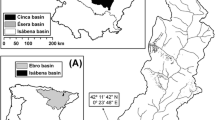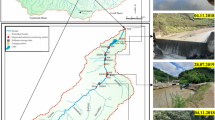Abstract
Hydrology and suspended sediment loading in the catchment of the natural Chini Lake (second largest natural lake in Malaysia) was investigated. Suspended sediment loads and discharge from seven selected feeder rivers were measured over a period of 1 year from January to December 2006. The river water flow rate during the sampling periods was relatively low, ranging from 0.001 to 1.31 m3/s or an average of 0.21 m3/s. The highest and lowest stream flow discharge rates were recorded from the Gumum and Cenahan River sub-catchment areas, respectively. The amount of sediment load ranged from 0.49 to 166.02 kg/km2/day or an average of 30.57 kg/km2/day in the study area. The highest sediment load was recorded in the wet season and the lowest in the dry season. Anthropogenic activities have significantly affected the hydrological functions and availability of the suspended sediments, and have thus influenced the variation in sediment output in the study area.








Similar content being viewed by others
References
Aha YS, Nakamura F, Mizugaki S (2008) Hydrology, suspended sediment dynamics and nutrient loading in Lake Takkobu, a degrading lake ecosystem in Kushiro Mire, northern Japan. Environ Monit Assess 145:267–281
Bobrovitskaya NN (2002) Erosion and sediment yield modelling in the former USSR. In: Summer W, Walling DE (eds) Modelling Erosion, Sediment Transport and Sediment Yield. UNESCO, Paris, pp 30–45
Bozali N, Yüksel A, Akay AE (2008) Determining the main factors effecting the sediment yield from derindere watershed of Sir Dam in Kahramanmaras by using GIS techniques. Int J Nat Eng Sci 2:29–32
Ceballas A, Schnabel S (1998) Hydrological behavior of a small catchment in the Dehesa land use system. J Hydrol 210:146–160
Conway D (2000) The climate and hydrology of the upper Blue Nile river. Geogr J 166:49–62
Darboux F, Gascuel-Odoux C, Davy P (2002) Effects of surface water storage by soil roughness on overland-flow generation. Earth Surf Proc Land 27:223–233
DOA (2006) Land use map of Tasik Chini, Malaysia. Scale 1:50,000. Director of National Mapping, Department of Agriculture, Putrajaya
Durieux L, Machado L, Laurent H (2003) The impact of deforestation on cloud cover over the Amazon area of deforestation. Remote Sens Environ 86:132–140
Evans BM, Lehning DW, Corradini KJ, Peterson GW, Nizeyimana E, Hamlett JM, Robillard PD, Day RL (2002) A comprehensive GISBased modeling approach for predicting nutrient loads in watersheds. J Spat Hydrol 2(2):1–18
Fried JS, Brown DG, Zweifler MO, Gold MA (2000) Mapping contributing areas of stormwater discharge to streams using terrain analysis. In: Wilson JP, Gallant JC (eds) Terrain analysis, principles and applications, 1st edn. John Wiley & Sons, New York, pp 183–203
Fu R, Li W (2004) The Influence of the land surface on the transition from dries to wet season in Amazonia. Theory Appl Climatol 78:97–110
Furtado JJ, Mori S (1982) Tasik Bera: The ecology of freshwater swamp. Junk Publication, Netherlands, Dr. W
Haboudane D, Bonn F, Royer A, Sommer S, Mehl W (2002) Land degradation and erosion risk mapping by fusion of spectrally based information and digital geomorphometric attributes. Int J Rem Sens 23:3795–3820
Haregeweyn N, Poesen J, Nyssen J, De Wit J, Haile M, Govers G, Deckers S (2006) Reservoirs in Tigray (Northern Ethiopia): characteristics and sediment deposition problems. Land Degrad Dev 17:211–230
Ismail BS, Mazlinda M, Tayeb MA (2013) Adsorption, desorption and mobility of cypermethrin and deltamethrin in Malaysian soils. Inter J Plant Animal Environ Sci 3(4):23–29
Ismail BS, Mazlinda M, Tayeb MA (2015a) The persistence of deltamethrin in Malaysian agricultural soils. Sains Malaysiana 44(1):83–89
Ismail BS, Choo LY, Salmijah S, Halimah M, Tayeb MA (2015b) Adsorption, desorption and mobility of cyfluthrin in three Malaysian tropical soils of different textures. J Environ Biol 36(5):1105–1111
Ismail BS, Prayitno S, Tayeb MA (2015c) Contamination of rice field water with sulfonylurea and phenoxy herbicides in the Muda irrigation scheme, Kedah. Malaysia. Environ Monit Assess 187(7):406. doi:10.1007/s10661-015-4600-9
Kirkby MJ, Irvine BJ, Jones RJA, Govers G (2008) The PESERA coarse scale erosion model for Europe. I—Model rationale and implementation. Eur J Soil Sci 59:1293–1306
Lewis J, Eads R (2001) Turbidity threshold sampling for suspended sediment load estimation. In: Proceedings, 7th Federal Interagency Sedimentation Conference, 25–29 Mar 2001, Reno, Nevada, pp III-110-III-117
McAnally WH, Parchure TM, Teeter AM (2001) Desktop method for estimating vessel-induced sediment suspension. J Hydraul Eng 127(7):577–587
Miller K, Pinter N, Van Der Ploeg RR, Wlosinski JH (2004) Recurrent shoaling and channel dredging, middle and upper Mississippi river, USA. J Hydrol 290(3–4):275–296
Mohd Ekhwan T (2005) Hydro meteorological condition and sediment yield in the upstream reach of Sungai Bebar, Pahang, Malaysia, biodiversity expedition, Peat swamp forest project, Pahang Forestry Department, Forest Research Institute Malaysia, pp 41–45
Nakamura F, Kameyama S, Mizugaki S (2004) Rapid shrinkage of Kushiro Mire, the largest mire in Japan, due to increased sedimentation associated with land-use development in the catchment. Catena 55:213–229
Pandey A, Chowdary VM, Mal BC, Billib M (2008) Runoff and sediment yield modeling from a small agricultural watershed in India using the WEPP model. J Hydrol 348:305–319
Reed DJ (2002) Sea-level rise and coastal marsh sustainability: geological and ecological factors in the Mississippi delta plain. Geomorphology 48(1–3):233–243
Robertson DM, Garn HS, Rose WJ, Juckem PF, Reneau P (2012) Hydrology, water quality, and response to simulated changes in phosphorus loading of Mercer Lake, Iron County, Wisconsin, with emphasis on effects of wastewater discharges on water quality: US Geological Survey Scientific Investigations Report 2012–5134, http://pubs.usgs.gov/sir/2012/5134/. Accessed 15 Nov 2014
Shields FD, Simon A, Steffen LJ (2000) Reservoir effects on downstream river channel migration. Environ Conserv 27(1):54–66
Sivakumar B (2002) A phase-space reconstruction approach to prediction of suspended sediment concentration in rivers. J Hydrol 258(1–4):149–162
Sivakumar B, Jayawardena AW (2003) Sediment transport phenomenon in rivers: an alternative perspective. Environ Modell Softw 18(8–9):831–838
Takamura N, Kadono Y, Fukushima M, Nakagawa M, Kim BHO (2003) Effects of aquatic macrophytes on water quality and phytoplankton communities in shallow lakes. Ecol Res 18:381–395
Tayeb MA, Ismail BS, Mardiana JK (2014) Method development recovery and validation of glufosinate ammonium from soil and water. 8th International Conference on Plant Protection in the Tropics 8–10 April, Kuala Lumpur, Malaysia. pp 109–110
Tayeb MA, Ismail BS, Mardiana JK (2015) Comparison of four different solid phase extraction cartridges for sample clean-up in the analysis of glufosinate ammonium from aqueous samples. Inter J ChemTech Res 7(6):2612–2619
Viessman W, Lewis GL (2003) Introduction to hydrology, 5th edn. Pearson Education Ltd, Upper Saddle River
Wetlands International Asia Pacific (1998) The ecological assessment of Tasik Chini Pahang, Peninsular Malaysia: an evaluation of its conservation value and environmental improvement requirements. WIAP, Kuala Lumpur
Acknowledgments
This study was conducted with financial support from the Ministry of Science and Technology, Malaysia through IRPA Grant Code: 09-02-02-0117-EA294, Zamalah Scheme and OUP fund (Code: UKM-OUP-FST-2008) UKM, Malaysia.
Author information
Authors and Affiliations
Corresponding author
Rights and permissions
About this article
Cite this article
Mir, S.I., Ismail, B.S. & Tayeb, M.A. Hydrology and sediment loading in a degrading natural lake system in Malaysia. Environ Earth Sci 75, 231 (2016). https://doi.org/10.1007/s12665-015-5006-2
Received:
Accepted:
Published:
DOI: https://doi.org/10.1007/s12665-015-5006-2




